Performance tuning in ranker
0 likes324 views
Ranker is a social platform that allows users to rank and list items. It faces challenges of large data volumes and traffic spikes. To address this, Ranker employs strategies like caching frequently accessed data, de-normalizing databases, using proper hardware, pre-calculating aggregated data, processing events asynchronously, and indexing data for fast searching. Through these techniques, Ranker is able to handle its performance issues and scale with increasing traffic.
1 of 12
Download to read offline

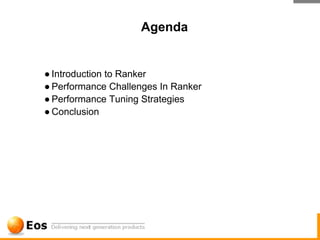
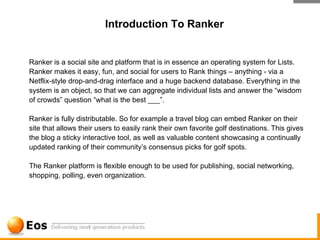
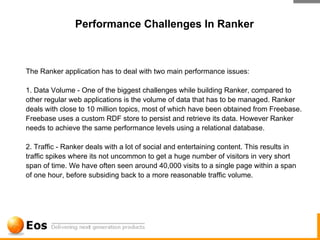
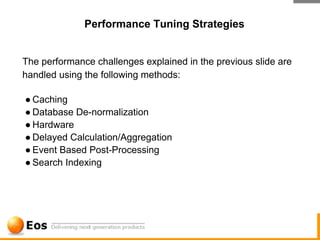
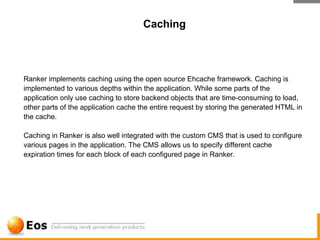
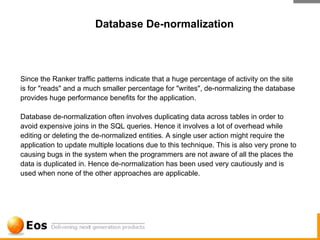

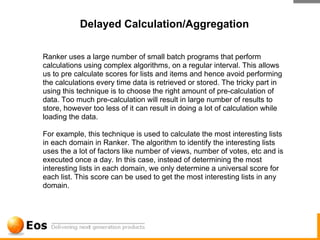

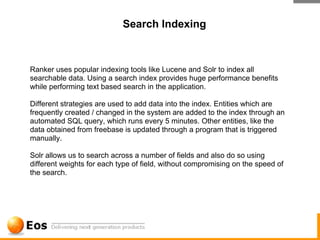
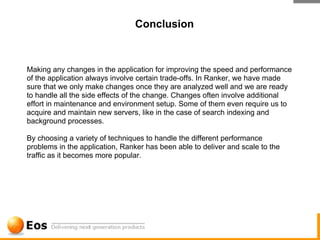
Ad
Recommended
Key to optimal end user experience
Key to optimal end user experienceManageEngine, Zoho Corporation
Ěý
The document outlines strategies for optimizing application performance and enhancing end user satisfaction through effective monitoring and troubleshooting techniques. Key components include identifying slow transactions, analyzing database performance, and utilizing application performance monitoring (APM) tools for insights. Upcoming modules focus on topics such as big data infrastructure and website monitoring strategies to ensure optimal user experience.Cloud applications monitoring in digital transformation era
Cloud applications monitoring in digital transformation eraManageEngine, Zoho Corporation
Ěý
The document provides insights into monitoring cloud applications within AWS, Azure, and Office 365, focusing on maximizing efficiency and diagnosing performance issues. It outlines the prerequisites for integrating these platforms with applications manager, highlights key performance metrics for AWS services, and details Azure monitoring capabilities as well as Office 365 performance metrics. Additionally, it emphasizes the importance of cloud analytics for effective resource planning.How to Spot a Great API
How to Spot a Great APIScribe Software Corp.
Ěý
The whitepaper outlines the seven essential traits of a strong data integration API, emphasizing the need for open standards, change data capture capabilities, performance efficiency, and user-friendly experience. It stresses that SaaS providers must view API integration as a core product capability vital for customer loyalty and successful application adoption. Additionally, the document introduces Scribe Online as a robust iPaaS solution designed to facilitate efficient data integration across various business applications.Ibm info sphere datastage tutorial part 1 architecture examples
Ibm info sphere datastage tutorial part 1 architecture examplesSandeep Sharma IIMK Smart City,IoT,Bigdata,Cloud,BI,DW
Ěý
The document discusses IBM InfoSphere DataStage and the IBM Information Server architecture. It describes the key components of IBM InfoSphere including DataStage, QualityStage and Information Services Director. It outlines the client-server architecture with client tier, server tiers, repository, engine and working areas. It also discusses data transformation stages, job execution parallelism techniques like pipeline and partition parallelism, and hash partitioning.Improving Reporting Performance
Improving Reporting PerformanceDhiren Gala
Ěý
The document discusses the common issue of slow report performance and identifies key factors that affect it, including report design, processing time, and database optimization. It provides scenarios and checklists for improving performance, emphasizing the importance of efficient queries and hardware optimization. Continuous monitoring and improvement strategies to enhance reporting are also highlighted.Introduction to microsoft sql server 2008 r2
Introduction to microsoft sql server 2008 r2Eduardo Castro
Ěý
In this presentation we review the new features in SQL 2008 R2.
Regards,
Ing. Eduardo Castro Martinez, PhD
http://comunidadwindows.org
http://ecastrom.blogspot.com Hybrid provider based on dso using real time data acquisition in sap bw 7.30
Hybrid provider based on dso using real time data acquisition in sap bw 7.30Sabyasachi Das
Ěý
This document provides steps to create a hybrid provider based on a data store object (DSO) using real-time data acquisition in SAP BW 7.30. It involves creating a data source, info packages, transformations, DSO, hybrid provider, daemon, and process chain. Real-time data is extracted from the source system and loaded into the DSO. A daemon then loads the delta from the DSO into the hybrid provider's info cube for historic querying and reporting.Building No-Code Collaboration Solutions on Office 365
Building No-Code Collaboration Solutions on Office 365Dragan Panjkov
Ěý
The document discusses the creation of no-code collaboration solutions using Office 365 for small and medium businesses. It describes a specific case involving a small health practice that implemented an efficient management system for patients and appointments without requiring dedicated IT infrastructure. Key features highlighted include customizable tools, efficient appointment scheduling, and the use of Office 365 services to enhance collaboration and data management.Keep Your Code Low, Low, Low, Low, Low: Getting to Digitally Driven With Orac...
Keep Your Code Low, Low, Low, Low, Low: Getting to Digitally Driven With Orac...Jim Czuprynski
Ěý
The document discusses the transition of utility companies towards a digitally driven approach with Oracle's converged database technology. It outlines the challenges faced by CIOs and the IT team related to customer data analysis, financial risks, and real-time data integration, while emphasizing the significance of adopting a converged database that supports multiple data types and workloads. The text also highlights various strategies for improving data processing, utilizing JSON and machine learning capabilities, and enhancing customer service and financial analysis through better data management practices.Closing the door on application performance problems
Closing the door on application performance problemsManageEngine, Zoho Corporation
Ěý
The document discusses application performance management, analyzing slow queries, and measuring end user satisfaction. It outlines the architecture of application performance management tools and provides insights on optimizing application and database performance. Additionally, it emphasizes the importance of monitoring end user interactions to enhance web application efficiency.Analysing data analytics use cases to understand big data platform
Analysing data analytics use cases to understand big data platformdataeaze systems
Ěý
The document analyzes data analytics use cases to elucidate the required features of big data ecosystem components necessary for enabling analytics. It discusses various categories of analytics such as static reports, dashboard reports, ad hoc data analysis, and business intelligence reporting, each with specific expectations from data platforms for processing and transforming data. Ultimately, it summarizes the features expected from data platforms to meet the demands of these diverse analytics use cases.My Experience of Salesforce Project
My Experience of Salesforce ProjectTejaswini Lambe
Ěý
The document outlines the overall approach and key steps for configuring a Salesforce application to meet requirements. It involves requirements analysis, solution design, configuration, testing, and training. Requirements are classified and key questions are asked to map them to Salesforce capabilities. Configuration involves building the data model, page layouts, automation using process builder, flows, validation rules, security, and reports/dashboards. Third party integration may also be needed. Testing and user training complete the implementation.SAP BODS 4.2
SAP BODS 4.2 TL Technologies - Thoughts Become Things
Ěý
This document describes new features in SAP Data Services 4.2 Support Package 1. Key updates include installing Data Services on a separate Information platform services system for flexibility, additional REST web services, enhanced operational statistics collection, and a new tool for securely promoting Data Services objects between environments.Apache kafka- Onkar Kadam
Apache kafka- Onkar KadamOnkar Kadam
Ěý
Apache Kafka is a distributed messaging system originally developed by LinkedIn to handle high volumes of log data with low latency. It allows for both online and offline data analysis and is highly scalable and efficient. Kafka uses a "pull model" where consumers pull messages from brokers in a distributed, fault-tolerant way coordinated by Zookeeper. Producers push messages to topics which are partitioned across brokers for scalability.Data Con LA 2018 - Standing on shoulders of giants by Sooraj Akkammadam
Data Con LA 2018 - Standing on shoulders of giants by Sooraj AkkammadamData Con LA
Ěý
The document discusses the optimization of data flow and marketing processes at Core Digital Media, focusing on the challenges related to data consumption timelines and optimization delays due to tight coupling of file processing. It outlines a solution involving a decoupled data pipeline architecture utilizing Kafka for real-time data processing and Spark for triggering reports. Key lessons learned emphasize the importance of consistent messaging protocols and improved ETL operations for effective data handling.SharePoint Intelligence Real World Business Workflow With Share Point Designe...
SharePoint Intelligence Real World Business Workflow With Share Point Designe...Ivan Sanders
Ěý
The document discusses the implementation and optimization of workflows in SharePoint Designer 2010, including prototyping in Visio, extending functionalities with Visual Studio, and the management of performance in SharePoint environments. It emphasizes the importance of proper configuration for crawling and indexing processes to mitigate performance issues and suggests strategies for managing large lists and database performance. Additionally, it includes a variety of resources and trusted blogs for further guidance on SharePoint best practices.Enterprise TUG Webinar 9.2 Upgrade 2-15-16
Enterprise TUG Webinar 9.2 Upgrade 2-15-16Mark Wu
Ěý
This document summarizes a webinar hosted by Mark Wu and Santosh Adari of NetApp on February 5th, 2016 about upgrading to Tableau 9.2 and demonstrating new features. The webinar agenda included an overview of why to upgrade to 9.2 by Mark Wu, how NetApp upgraded their Tableau Server to 9.2 by Santosh Adari, and what's new in Tableau 9.2 and 9.1 by Mark Wu. The document also provides details about NetApp's large Tableau deployment and Mark Wu's demonstration of new features in Tableau 9.2 like visual analytics improvements, server changes, and performance enhancements.What Sharon does in_Project Server 2013
What Sharon does in_Project Server 2013Sharon Rene Summers
Ěý
The document describes services provided for building and configuring a Project Server 2013 environment. These services include performing business analysis, architecture design, setup and configuration, security access setup, migration of project plans to the Project Server database, training, and acting as a liaison between business units and for integrations. The services also involve implementing frameworks, handling licensing agreements, and advising on integrations with other applications.SQLlite and Full Text Search Presentation
SQLlite and Full Text Search Presentationleximo
Ěý
SQLite is a small, self-contained, zero-configuration, transactional SQL database that requires no setup or administration. It is widely used due to its small size and simplicity, with no server dependency or configuration required. SQLite is ideal for lightweight database needs such as embedded systems and websites, and includes a full-text search engine for indexing and searching large bodies of text.Large Data Management Strategies
Large Data Management StrategiesSalesforce Developers
Ěý
The document discusses various aspects of managing large data volumes in Salesforce, addressing risks, strategies, and operational challenges associated with data loads, extracts, and cleanups. It emphasizes the use of Salesforce's Bulk API for efficient data handling and outlines best practices for data loading, validation, and cleanup processes. Additionally, it provides recommendations for optimizing performance and managing the complexity of large-scale data operations.SAP HANA - Understanding the Basics
SAP HANA - Understanding the Basics Global Business Solutions SME
Ěý
SAP HANA is an advanced in-memory analytics platform designed to handle large volumes of data in real-time, enabling companies to perform ad hoc analysis and streamline business processes. It addresses challenges related to big data, providing faster decision-making through enhanced reporting, predictive analysis, and reduced reliance on IT resources. Key features include its columnar storage capabilities, multiple computing engines, and various use cases across industries for operational insights.Querona Presentation 2018
Querona Presentation 2018Synergo!
Ěý
Querona is a data virtualization platform that connects diverse data sources, allowing users to generate SQL queries without ETL and in real-time. It aims to simplify business intelligence by eliminating time-consuming processes and reducing reliance on IT, making data analysis more accessible to business users. With features like powerful execution engines and seamless integration with BI tools, Querona enhances performance and flexibility in data management.Performance tuning and optimization (ppt)
Performance tuning and optimization (ppt)Harish Chand
Ěý
The document discusses various ways to improve client/server performance at both the client and server level. It addresses:
1) Client performance can be improved by optimizing hardware and software. Hardware optimizations include using the fastest available components, while software optimizations involve improving the operating system and applications.
2) Server performance can also be improved through hardware upgrades like adding network cards, as well as implementing high-performance file systems and offloading processing to servers.
3) Database performance optimizations involve efficient index design, query design, and database normalization to minimize network traffic and process data faster.Optimizing JMS Performance for Cloud-based Application Servers
Optimizing JMS Performance for Cloud-based Application ServersZhenyun Zhuang
Ěý
The document discusses optimizing Java Message Service (JMS) performance for cloud-based applications, highlighting its significance in Java Enterprise Edition (Java EE) contexts. It presents strategies to enhance JMS performance which include matching storage block sizes with message sizes, implementing distributed persistent stores, and selecting appropriate storage profiles, all while conducting performance evaluations. The work aims to ensure reliable, scalable, and efficient messaging services in cloud environments crucial for modern business applications.Eossys
EossysEosSoftware
Ěý
EOS Software Systems is a technology company founded in 2007 with offices in Bangalore, India and Los Angeles, California. They have over 100 years of combined IT experience across web and enterprise applications. Their mission is to deliver cutting-edge solutions to build the future of the web. They have expertise in areas like product incubation, enterprise applications, social gaming and mobile applications. They work with clients across various industries and have experience delivering large, complex projects.Ranker jms implementation
Ranker jms implementationEosSoftware
Ěý
This document provides an overview of using a JMS (Java Message Service) implementation like Apache ActiveMQ for asynchronous event processing in a ranker system. It discusses why messaging is useful, challenges in selecting a JMS provider and ActiveMQ, how JMS and point-to-point messaging works, key ActiveMQ features, and some other JMS provider options.Achieving quality with tools case study
Achieving quality with tools case studyEosSoftware
Ěý
The document discusses various techniques for achieving quality in software development, including static analysis tools. It describes how bugs occur due to human errors and complex codebases, and that testing alone cannot find all bugs. It then explains static analysis tools like FindBugs and PMD that can automatically find bugs, the challenges of static analysis, distinguishing bugs from style issues, and how tools like Eclipse and EclEmma are used to fix bugs and measure test coverage. The overall goal is to reduce bugs escaping to production through efficient tooling and quality practices.The Six Highest Performing B2B Blog Post Formats
The Six Highest Performing B2B Blog Post FormatsBarry Feldman
Ěý
The document outlines six high-performing blog post formats for B2B content, including how-to guides, research insights, case studies, infographics, authoritative news, and hot topics. Each format is designed to generate social media shares and backlinks, enhancing search results. The content aims to position companies as authoritative leaders in their industry.The Outcome Economy
The Outcome EconomyHelge Tennø
Ěý
1) The document discusses the opportunity for technology to improve organizational efficiency and transition economies into a "smart and clean world."
2) It argues that aggregate efficiency has stalled at around 22% for 30 years due to limitations of the Second Industrial Revolution, but that digitizing transport, energy, and communication through technologies like blockchain can help manage resources and increase efficiency.
3) Technologies like precision agriculture, cloud computing, robotics, and autonomous vehicles may allow for "dematerialization" and do more with fewer physical resources through effects like reduced waste and need for transportation/logistics infrastructure.Starting a search application
Starting a search applicationLucidworks (Archived)
Ěý
The document provides guidance on initial steps for developing a search application, including validating the need for full-text search, identifying ideal search results, considering clustering results, and producing requirements and choosing a technology. Some key recommendations include sketching out ideal results for sample queries, determining how results should be ordered and presented, and considering if and how results could be clustered. Determining ideal results and clustering options can help drive specific requirements and the selection of an appropriate technology.More Related Content
What's hot (15)
Keep Your Code Low, Low, Low, Low, Low: Getting to Digitally Driven With Orac...
Keep Your Code Low, Low, Low, Low, Low: Getting to Digitally Driven With Orac...Jim Czuprynski
Ěý
The document discusses the transition of utility companies towards a digitally driven approach with Oracle's converged database technology. It outlines the challenges faced by CIOs and the IT team related to customer data analysis, financial risks, and real-time data integration, while emphasizing the significance of adopting a converged database that supports multiple data types and workloads. The text also highlights various strategies for improving data processing, utilizing JSON and machine learning capabilities, and enhancing customer service and financial analysis through better data management practices.Closing the door on application performance problems
Closing the door on application performance problemsManageEngine, Zoho Corporation
Ěý
The document discusses application performance management, analyzing slow queries, and measuring end user satisfaction. It outlines the architecture of application performance management tools and provides insights on optimizing application and database performance. Additionally, it emphasizes the importance of monitoring end user interactions to enhance web application efficiency.Analysing data analytics use cases to understand big data platform
Analysing data analytics use cases to understand big data platformdataeaze systems
Ěý
The document analyzes data analytics use cases to elucidate the required features of big data ecosystem components necessary for enabling analytics. It discusses various categories of analytics such as static reports, dashboard reports, ad hoc data analysis, and business intelligence reporting, each with specific expectations from data platforms for processing and transforming data. Ultimately, it summarizes the features expected from data platforms to meet the demands of these diverse analytics use cases.My Experience of Salesforce Project
My Experience of Salesforce ProjectTejaswini Lambe
Ěý
The document outlines the overall approach and key steps for configuring a Salesforce application to meet requirements. It involves requirements analysis, solution design, configuration, testing, and training. Requirements are classified and key questions are asked to map them to Salesforce capabilities. Configuration involves building the data model, page layouts, automation using process builder, flows, validation rules, security, and reports/dashboards. Third party integration may also be needed. Testing and user training complete the implementation.SAP BODS 4.2
SAP BODS 4.2 TL Technologies - Thoughts Become Things
Ěý
This document describes new features in SAP Data Services 4.2 Support Package 1. Key updates include installing Data Services on a separate Information platform services system for flexibility, additional REST web services, enhanced operational statistics collection, and a new tool for securely promoting Data Services objects between environments.Apache kafka- Onkar Kadam
Apache kafka- Onkar KadamOnkar Kadam
Ěý
Apache Kafka is a distributed messaging system originally developed by LinkedIn to handle high volumes of log data with low latency. It allows for both online and offline data analysis and is highly scalable and efficient. Kafka uses a "pull model" where consumers pull messages from brokers in a distributed, fault-tolerant way coordinated by Zookeeper. Producers push messages to topics which are partitioned across brokers for scalability.Data Con LA 2018 - Standing on shoulders of giants by Sooraj Akkammadam
Data Con LA 2018 - Standing on shoulders of giants by Sooraj AkkammadamData Con LA
Ěý
The document discusses the optimization of data flow and marketing processes at Core Digital Media, focusing on the challenges related to data consumption timelines and optimization delays due to tight coupling of file processing. It outlines a solution involving a decoupled data pipeline architecture utilizing Kafka for real-time data processing and Spark for triggering reports. Key lessons learned emphasize the importance of consistent messaging protocols and improved ETL operations for effective data handling.SharePoint Intelligence Real World Business Workflow With Share Point Designe...
SharePoint Intelligence Real World Business Workflow With Share Point Designe...Ivan Sanders
Ěý
The document discusses the implementation and optimization of workflows in SharePoint Designer 2010, including prototyping in Visio, extending functionalities with Visual Studio, and the management of performance in SharePoint environments. It emphasizes the importance of proper configuration for crawling and indexing processes to mitigate performance issues and suggests strategies for managing large lists and database performance. Additionally, it includes a variety of resources and trusted blogs for further guidance on SharePoint best practices.Enterprise TUG Webinar 9.2 Upgrade 2-15-16
Enterprise TUG Webinar 9.2 Upgrade 2-15-16Mark Wu
Ěý
This document summarizes a webinar hosted by Mark Wu and Santosh Adari of NetApp on February 5th, 2016 about upgrading to Tableau 9.2 and demonstrating new features. The webinar agenda included an overview of why to upgrade to 9.2 by Mark Wu, how NetApp upgraded their Tableau Server to 9.2 by Santosh Adari, and what's new in Tableau 9.2 and 9.1 by Mark Wu. The document also provides details about NetApp's large Tableau deployment and Mark Wu's demonstration of new features in Tableau 9.2 like visual analytics improvements, server changes, and performance enhancements.What Sharon does in_Project Server 2013
What Sharon does in_Project Server 2013Sharon Rene Summers
Ěý
The document describes services provided for building and configuring a Project Server 2013 environment. These services include performing business analysis, architecture design, setup and configuration, security access setup, migration of project plans to the Project Server database, training, and acting as a liaison between business units and for integrations. The services also involve implementing frameworks, handling licensing agreements, and advising on integrations with other applications.SQLlite and Full Text Search Presentation
SQLlite and Full Text Search Presentationleximo
Ěý
SQLite is a small, self-contained, zero-configuration, transactional SQL database that requires no setup or administration. It is widely used due to its small size and simplicity, with no server dependency or configuration required. SQLite is ideal for lightweight database needs such as embedded systems and websites, and includes a full-text search engine for indexing and searching large bodies of text.Large Data Management Strategies
Large Data Management StrategiesSalesforce Developers
Ěý
The document discusses various aspects of managing large data volumes in Salesforce, addressing risks, strategies, and operational challenges associated with data loads, extracts, and cleanups. It emphasizes the use of Salesforce's Bulk API for efficient data handling and outlines best practices for data loading, validation, and cleanup processes. Additionally, it provides recommendations for optimizing performance and managing the complexity of large-scale data operations.SAP HANA - Understanding the Basics
SAP HANA - Understanding the Basics Global Business Solutions SME
Ěý
SAP HANA is an advanced in-memory analytics platform designed to handle large volumes of data in real-time, enabling companies to perform ad hoc analysis and streamline business processes. It addresses challenges related to big data, providing faster decision-making through enhanced reporting, predictive analysis, and reduced reliance on IT resources. Key features include its columnar storage capabilities, multiple computing engines, and various use cases across industries for operational insights.Querona Presentation 2018
Querona Presentation 2018Synergo!
Ěý
Querona is a data virtualization platform that connects diverse data sources, allowing users to generate SQL queries without ETL and in real-time. It aims to simplify business intelligence by eliminating time-consuming processes and reducing reliance on IT, making data analysis more accessible to business users. With features like powerful execution engines and seamless integration with BI tools, Querona enhances performance and flexibility in data management.Performance tuning and optimization (ppt)
Performance tuning and optimization (ppt)Harish Chand
Ěý
The document discusses various ways to improve client/server performance at both the client and server level. It addresses:
1) Client performance can be improved by optimizing hardware and software. Hardware optimizations include using the fastest available components, while software optimizations involve improving the operating system and applications.
2) Server performance can also be improved through hardware upgrades like adding network cards, as well as implementing high-performance file systems and offloading processing to servers.
3) Database performance optimizations involve efficient index design, query design, and database normalization to minimize network traffic and process data faster.Viewers also liked (6)
Optimizing JMS Performance for Cloud-based Application Servers
Optimizing JMS Performance for Cloud-based Application ServersZhenyun Zhuang
Ěý
The document discusses optimizing Java Message Service (JMS) performance for cloud-based applications, highlighting its significance in Java Enterprise Edition (Java EE) contexts. It presents strategies to enhance JMS performance which include matching storage block sizes with message sizes, implementing distributed persistent stores, and selecting appropriate storage profiles, all while conducting performance evaluations. The work aims to ensure reliable, scalable, and efficient messaging services in cloud environments crucial for modern business applications.Eossys
EossysEosSoftware
Ěý
EOS Software Systems is a technology company founded in 2007 with offices in Bangalore, India and Los Angeles, California. They have over 100 years of combined IT experience across web and enterprise applications. Their mission is to deliver cutting-edge solutions to build the future of the web. They have expertise in areas like product incubation, enterprise applications, social gaming and mobile applications. They work with clients across various industries and have experience delivering large, complex projects.Ranker jms implementation
Ranker jms implementationEosSoftware
Ěý
This document provides an overview of using a JMS (Java Message Service) implementation like Apache ActiveMQ for asynchronous event processing in a ranker system. It discusses why messaging is useful, challenges in selecting a JMS provider and ActiveMQ, how JMS and point-to-point messaging works, key ActiveMQ features, and some other JMS provider options.Achieving quality with tools case study
Achieving quality with tools case studyEosSoftware
Ěý
The document discusses various techniques for achieving quality in software development, including static analysis tools. It describes how bugs occur due to human errors and complex codebases, and that testing alone cannot find all bugs. It then explains static analysis tools like FindBugs and PMD that can automatically find bugs, the challenges of static analysis, distinguishing bugs from style issues, and how tools like Eclipse and EclEmma are used to fix bugs and measure test coverage. The overall goal is to reduce bugs escaping to production through efficient tooling and quality practices.The Six Highest Performing B2B Blog Post Formats
The Six Highest Performing B2B Blog Post FormatsBarry Feldman
Ěý
The document outlines six high-performing blog post formats for B2B content, including how-to guides, research insights, case studies, infographics, authoritative news, and hot topics. Each format is designed to generate social media shares and backlinks, enhancing search results. The content aims to position companies as authoritative leaders in their industry.The Outcome Economy
The Outcome EconomyHelge Tennø
Ěý
1) The document discusses the opportunity for technology to improve organizational efficiency and transition economies into a "smart and clean world."
2) It argues that aggregate efficiency has stalled at around 22% for 30 years due to limitations of the Second Industrial Revolution, but that digitizing transport, energy, and communication through technologies like blockchain can help manage resources and increase efficiency.
3) Technologies like precision agriculture, cloud computing, robotics, and autonomous vehicles may allow for "dematerialization" and do more with fewer physical resources through effects like reduced waste and need for transportation/logistics infrastructure.Ad
Similar to Performance tuning in ranker (20)
Starting a search application
Starting a search applicationLucidworks (Archived)
Ěý
The document provides guidance on initial steps for developing a search application, including validating the need for full-text search, identifying ideal search results, considering clustering results, and producing requirements and choosing a technology. Some key recommendations include sketching out ideal results for sample queries, determining how results should be ordered and presented, and considering if and how results could be clustered. Determining ideal results and clustering options can help drive specific requirements and the selection of an appropriate technology.Efficient Crawling Through Dynamic Priority of Web Page in Sitemap
Efficient Crawling Through Dynamic Priority of Web Page in Sitemapieij1
Ěý
A web crawler or automatic indexer is used to download updated information from World Wide Web (www) for search engine. It is estimated that current size of Google index is approx 8*109 pages and crawling costs could be around 4 million dollars for a full crawl if only considered network costs. Thus we need to download only most important pages. In order toward, we propose “Efficient crawling through dynamic page priority of web pages in Sitemap” which is query based approach to inform most important pages to web crawler through sitemap protocol in dynamic page priority. Through the page priority web crawler can find most important pages from any website and may just download them. Experimental results reveal our approach has better performance than existing approach.
Business Intelligence Solution Using Search Engine
Business Intelligence Solution Using Search Engineankur881120
Ěý
The document describes a business intelligence solution that uses a search engine to index and search web pages. It discusses using crawlers to index web pages and store them in a repository. An indexer then generates an inverted index from the repository to support keyword searches. The system architecture includes the repository, indexer, and search functionality. It also describes the database structure used to store crawled URLs, the index, and search results. The project aims to build a basic search engine to demonstrate the proposed business intelligence solution.10 tips-for-optimizing-sql-server-performance-white-paper-22127
10 tips-for-optimizing-sql-server-performance-white-paper-22127Kaizenlogcom
Ěý
This document provides 10 tips for optimizing SQL Server performance, with the main tips being to establish a performance baseline before making changes, determine clear goals for optimization, and limit changes between benchmarks to isolate the effects of individual changes. Benchmarking against an established baseline helps identify abnormal behavior and measure the impact of performance improvements. The tips are meant to provide a process for using performance data to identify and address specific performance issues.System Design
System DesignSyeedAbrarZaoad1
Ěý
The document provides an overview of how to design a system to scale from serving a single user to millions of users. It begins with a single server setup and discusses moving to multiple servers, using a database, scaling vertically by adding resources to servers versus horizontally by adding more servers, and using a load balancer to distribute traffic across servers for redundancy and high availability. It provides examples of scaling a system architecture in a step-by-step manner.system-design-interview-an-insiders-guide-2nbsped-9798664653403.pdf
system-design-interview-an-insiders-guide-2nbsped-9798664653403.pdfParthNavale
Ěý
The document provides an overview of how to design a system to scale from serving a single user to millions of users. It begins with a single server setup and discusses moving to multiple servers, using a database, scaling vertically by adding resources to servers versus horizontally by adding more servers, and using a load balancer to distribute traffic across servers for redundancy and high availability. It provides examples of scaling a system architecture in a step-by-step manner.Data mining in web search engine optimization
Data mining in web search engine optimizationBookStoreLib
Ěý
This document presents a proposed approach for optimizing web search by incorporating user feedback to improve result rankings. The approach uses keyword analysis on the user query to initially retrieve and rank relevant web pages. It then analyzes user responses like likes/dislikes and visit counts to update the page rankings. Experimental results on sample education queries show how page rankings change as user responses increase likes for certain pages. The approach aims to provide more useful search results by better reflecting individual user preferences.Web Search Engine, Web Crawler, and Semantics Web
Web Search Engine, Web Crawler, and Semantics WebAatif19921
Ěý
The document discusses web search engines, their evolution, search algorithms, and challenges faced in information retrieval. It also introduces the semantic web and its applications, as well as web crawling, data extraction, and indexing techniques. Furthermore, it evaluates search quality, similarity measures, and the importance of hyperlink ranking algorithms in analyzing web structures.Nondeterministic Software for the Rest of Us
Nondeterministic Software for the Rest of UsTomer Gabel
Ěý
The document discusses the challenges of developing nondeterministic software, particularly in areas like search engines and social analytics, emphasizing that successful metrics are crucial for understanding user needs and service quality. It highlights that traditional acceptance testing is insufficient for qualitative software tasks and stresses the importance of continuous measurement and improvement through customer feedback and data analysis. Overall, the presentation underscores the separation of 'correct' from 'good' software and the need for adaptive strategies to enhance user experience.Enterprise performance engineering solutions
Enterprise performance engineering solutionsInfosys
Ěý
This document discusses performance engineering and global software development. It describes Infosys' approach which combines performance engineering practices with client delivery experience. This includes workload and performance modeling, benchmarking, tuning, and optimization methodologies to deliver high-performance systems with reduced costs and timelines. The key aspects of the approach are system requirements, modeling, performance testing and benchmarking, and optimization and tuning.Performance Tuning
Performance TuningJannet Peetz
Ěý
This document discusses tuning a system for optimal performance. It covers determining performance criteria, analyzing problems, testing solutions, and signs of a well-tuned system. Key aspects of tuning include analyzing system usage, determining causes of problems, setting goals to improve throughput or response times, and testing changes. Memory, processors, I/O, and network usage should be optimized to avoid bottlenecks.Enterprise Search: Addressing the First Problem of Big Data & Analytics - Sta...
Enterprise Search: Addressing the First Problem of Big Data & Analytics - Sta...StampedeCon
Ěý
Enterprise search aims to identify and enable content from multiple enterprise sources to be indexed, searched, and displayed. It faces challenges like unifying diverse data sources, identifying relevant information in real-time, and providing action-oriented insights. Machine learning techniques can help by automatically classifying and clustering data, extracting entities and sentiments, and personalizing search results. Case studies demonstrate how enterprise search has helped organizations in healthcare, telecommunications, finance, and sports improve productivity, customer service, and data-driven insights.Share point 2010 performance and capacity planning best practices
Share point 2010 performance and capacity planning best practicesEric Shupps
Ěý
This document provides an overview of SharePoint 2010 performance and capacity planning best practices. It discusses infrastructure considerations like network configuration, server design based on workload, and database sizing calculations. It also covers configuration techniques such as caching, compression, throttling and monitoring. Specific areas covered in more detail include pages, customizations, branding, and large lists. The presentation includes demonstrations of tools like the developer dashboard for performance troubleshooting.SMART CRAWLER: A TWO-STAGE CRAWLER FOR EFFICIENTLY HARVESTING DEEP-WEB INTERF...
SMART CRAWLER: A TWO-STAGE CRAWLER FOR EFFICIENTLY HARVESTING DEEP-WEB INTERF...CloudTechnologies
Ěý
The document presents 'Smart Crawler,' a two-stage framework designed to efficiently harvest deep-web interfaces. It employs site-based searching and adaptive link-ranking to prioritize relevant web resources, achieving higher harvest rates and accuracy compared to traditional crawlers. Experimental results indicate the framework's efficacy in retrieving deep-web content from large sites while maintaining wide coverage.Business owner findability interview questions
Business owner findability interview questionsRavi Mynampaty
Ěý
This document outlines interview questions for business owners regarding the findability of web and intranet properties at Harvard Business School. It covers user interface optimization, user behavior, content indexing, and search management to enhance search functionality. The aim is to gather insights to inform the development of findability standards and improve the overall search experience within HBS digital resources.Share point 2013 enterprise search (public)
Share point 2013 enterprise search (public)Petter Skodvin-Hvammen
Ěý
This document summarizes key learnings from a presentation about SharePoint 2013 and Enterprise Search. It discusses how to run a successful search project through planning, development, testing and deployment. It also covers infrastructure needs and capacity testing findings. Additionally, it provides examples of how to customize the user experience through display templates and Front search. Methods for crawling thousands of file shares and enriching indexed content are presented. The document concludes with discussions on relevancy, managing property weighting, changing ranking models, and tuning search results.Brochure quiterian DDWeb
Brochure quiterian DDWebJosep Arroyo
Ěý
The document discusses Quiterian, a data mining and predictive analysis platform that helps companies get more value from data sooner, anticipate the future to react earlier, and empower users while reducing IT costs. It provides fast data loading and exploration without limits, dynamic analysis and predictive modeling techniques, and easy report publishing and distribution. A typical implementation takes less than a month and requires minimal IT resources. Quiterian has been used by leading organizations in various industries.Informix health check - Brochure
Informix health check - BrochureVyasaka Technologies Pte Ltd
Ěý
This brochure describes Informix Health Check Services which include monitoring and performance tuning for Informix databases. The services analyze current systems and provide a report with recommendations to address potential problems, prevent future issues, and improve overall performance. Standard deliverables include reviewing the Informix environment, configuration, logs, statistics, jobs and providing a diagnostic report with optimization recommendations. Optional services include DBA support and application maintenance.Phpconf2008 Sphinx En
Phpconf2008 Sphinx EnMurugan Krishnamoorthy
Ěý
The document describes how Sphinx, an open source full-text search engine, was used to optimize searching and reporting on a large dataset of over 160 million cross-links. The data was partitioned across 8 servers each with 4 Sphinx instances and 2 indexes. Queries were run in parallel across the instances to return results faster than could be achieved with a single database, with average query times under 0.125 seconds and 95% of queries returning under 0.352 seconds. The document outlines the partitioning, indexing, and querying approach used to optimize performance for the dataset.IRJET - Building Your Own Search Engine
IRJET - Building Your Own Search EngineIRJET Journal
Ěý
This document describes a student project to build a basic web search engine. It discusses the key components of a search engine including a web crawler to scan websites and index their content, an indexer to organize the scanned content in a database, and a search interface to retrieve relevant results from the database based on keyword queries. The proposed project will implement a web crawler that crawls websites in a breadth-first manner, calculates page scores based on keyword and link counts, and returns the top 30 highest scoring pages to users in response to search queries. The goals of the project are to gain experience implementing basic search engine functionality through web crawling, indexing, and ranking algorithms.Ad
Performance tuning in ranker
- 1. Performance Tuning In Ranker. com
- 2. Agenda â—Ź Introduction to Ranker â—Ź Performance Challenges In Ranker â—Ź Performance Tuning Strategies â—Ź Conclusion
- 3. Introduction To Ranker Ranker is a social site and platform that is in essence an operating system for Lists. Ranker makes it easy, fun, and social for users to Rank things – anything - via a Netflix-style drop-and-drag interface and a huge backend database. Everything in the system is an object, so that we can aggregate individual lists and answer the “wisdom of crowds” question “what is the best ___”. Ranker is fully distributable. So for example a travel blog can embed Ranker on their site that allows their users to easily rank their own favorite golf destinations. This gives the blog a sticky interactive tool, as well as valuable content showcasing a continually updated ranking of their community’s consensus picks for golf spots. The Ranker platform is flexible enough to be used for publishing, social networking, shopping, polling, even organization.
- 4. Performance Challenges In Ranker The Ranker application has to deal with two main performance issues: 1. Data Volume - One of the biggest challenges while building Ranker, compared to other regular web applications is the volume of data that has to be managed. Ranker deals with close to 10 million topics, most of which have been obtained from Freebase. Freebase uses a custom RDF store to persist and retrieve its data. However Ranker needs to achieve the same performance levels using a relational database. 2. Traffic - Ranker deals with a lot of social and entertaining content. This results in traffic spikes where its not uncommon to get a huge number of visitors in very short span of time. We have often seen around 40,000 visits to a single page within a span of one hour, before subsiding back to a more reasonable traffic volume.
- 5. Performance Tuning Strategies The performance challenges explained in the previous slide are handled using the following methods: â—Ź Caching â—Ź Database De-normalization â—Ź Hardware â—Ź Delayed Calculation/Aggregation â—Ź Event Based Post-Processing â—Ź Search Indexing
- 6. Caching Ranker implements caching using the open source Ehcache framework. Caching is implemented to various depths within the application. While some parts of the application only use caching to store backend objects that are time-consuming to load, other parts of the application cache the entire request by storing the generated HTML in the cache. Caching in Ranker is also well integrated with the custom CMS that is used to configure various pages in the application. The CMS allows us to specify different cache expiration times for each block of each configured page in Ranker.
- 7. Database De-normalization Since the Ranker traffic patterns indicate that a huge percentage of activity on the site is for "reads" and a much smaller percentage for "writes", de-normalizing the database provides huge performance benefits for the application. Database de-normalization often involves duplicating data across tables in order to avoid expensive joins in the SQL queries. Hence it involves a lot of overhead while editing or deleting the de-normalized entities. A single user action might require the application to update multiple locations due to this technique. This is also very prone to causing bugs in the system when the programmers are not aware of all the places the data is duplicated in. Hence de-normalization has been used very cautiously and is used when none of the other approaches are applicable.
- 8. Hardware Using better hardware is often a much simpler and cheaper option than investing a lot of time in improving the performance of some parts of the application. We have made sure that we have the most suitable hardware for the systems that are being built, based on the amount of memory and processing power needed. Ranker also uses hardware load balancers to distribute the load across multiple web servers. This makes a huge difference when there is a spike in traffic, as mentioned in the “Performance Challenges In Ranker” section. Here is one situation where coding for better hardware made a huge difference to the performance: One of the background processes in Ranker required to make around 9 million queries to be able to complete its job. Later we realized that by loading all the data into memory in one shot, we could reduce the number of queries to a few thousand. However this would require us store around 3GB of data in memory. Hence it made more sense to get systems with bigger memory capacity. This change resulted in the performance increasing by about 20 times.
- 9. Delayed Calculation/Aggregation Ranker uses a large number of small batch programs that perform calculations using complex algorithms, on a regular interval. This allows us to pre calculate scores for lists and items and hence avoid performing the calculations every time data is retrieved or stored. The tricky part in using this technique is to choose the right amount of pre-calculation of data. Too much pre-calculation will result in large number of results to store, however too less of it can result in doing a lot of calculation while loading the data. For example, this technique is used to calculate the most interesting lists in each domain in Ranker. The algorithm to identify the interesting lists uses the a lot of factors like number of views, number of votes, etc and is executed once a day. In this case, instead of determining the most interesting lists in each domain, we only determine a universal score for each list. This score can be used to get the most interesting lists in any domain.
- 10. Event Based Post-Processing This is another form of Delayed Calculation. Some of the user actions in Ranker will need the system to sometimes perform complex/time- consuming operations. For cases like these, Ranker uses an event based post-processing framework to perform these operations asynchronously. This will allow us to give the user a quick response time and also perform time-consuming operations within a few seconds after the action. The only disadvantage in using this approach is the difficulty it causes in reporting errors and failures to the user. For example, when someone comments on a list, we need to notify the list author through an email. Even though the list author needs to be notified immediately, having a delay of a few seconds is acceptable. Performing this asynchronously will allow us to give a quick response to the user without having the user wait for the email to be sent.
- 11. Search Indexing Ranker uses popular indexing tools like Lucene and Solr to index all searchable data. Using a search index provides huge performance benefits while performing text based search in the application. Different strategies are used to add data into the index. Entities which are frequently created / changed in the system are added to the index through an automated SQL query, which runs every 5 minutes. Other entities, like the data obtained from freebase is updated through a program that is triggered manually. Solr allows us to search across a number of fields and also do so using different weights for each type of field, without compromising on the speed of the search.
- 12. Conclusion Making any changes in the application for improving the speed and performance of the application always involve certain trade-offs. In Ranker, we have made sure that we only make changes once they are analyzed well and we are ready to handle all the side effects of the change. Changes often involve additional effort in maintenance and environment setup. Some of them even require us to acquire and maintain new servers, like in the case of search indexing and background processes. By choosing a variety of techniques to handle the different performance problems in the application, Ranker has been able to deliver and scale to the traffic as it becomes more popular.